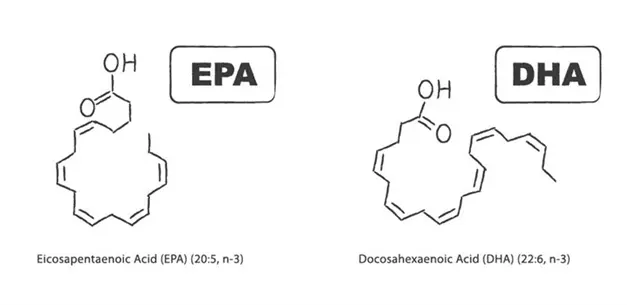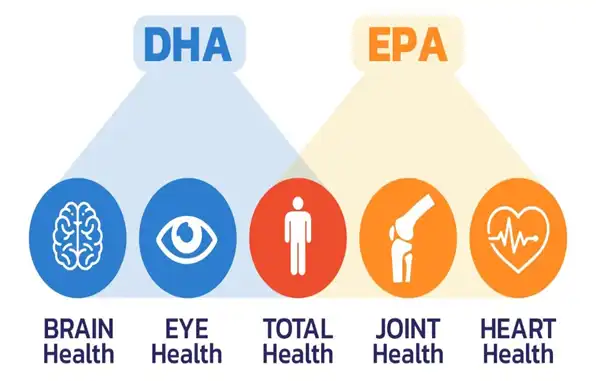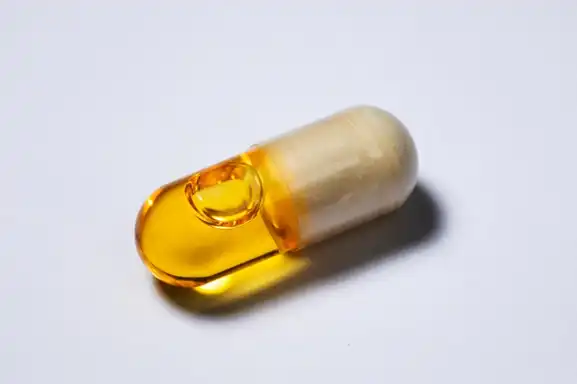Omega 3 fatty acids EPA vs DHA
Unlocking the Power of Omega-3 Fatty Acids: Essential Benefits for Mind, Body, and Heart
In the ever-evolving landscape of health and wellness, certain nutrients continue to stand out due to their scientifically backed benefits and profound impact on our well-being. Omega-3 fatty acids are among these powerhouse nutrients, often hailed as essential for everything from heart health to brain function. But what exactly are omega-3 fatty acids, and why are they so crucial to incorporate into our diets? Let’s dive into the essentials you need to know about omega-3s and why they deserve a permanent spot on your plate.
What Are Omega-3 Fatty Acids?
Omega-3 fatty acids are polyunsaturated fats that play a critical role in the body's overall functioning. Unlike other fats, omega-3s cannot be synthesized by the body and thus must be obtained through diet or supplements. There are three primary types of omega-3 fatty acids:
ALA (Alpha-linolenic acid): Found mainly in plant oils such as flaxseed, chia seeds, and walnuts, ALA is the most common omega-3 in the diet.
EPA (Eicosapentaenoic acid): Primarily found in fish and other seafood, EPA is known for its powerful anti-inflammatory properties.
DHA (Docosahexaenoic acid): Also found in fish, DHA is a vital component of the brain and retina, supporting cognitive and visual health.
Each of these types serves a unique purpose, and together they create a robust foundation for optimal health.
What's the difference between EPA and DHA?
Omega-3 fatty acids like EPA and DHA form the basic building blocks of your physical health. They also carry out more specified functions, like regulating cell receptors and providing the basis for some hormones.
Each omega-3 fatty acid has its specific role in the body. Here’s a brief sum-up of how EPA and DHA differ:
- · EPA – EPA is a 20-carbon fatty acid. Its primary function is to produce eicosanoids, which are chemicals that combat inflammation. EPA can be converted into DHA within the liver.
- · DHA – DHA is a 22-carbon fatty acid. DHA plays a notable role in brain and eye health. It also supports babies' growth and development during pregnancy and early childhood.
Our bodies don’t produce enough EPA, DHA, and other omega-3 fatty acids on their own, so we must ingest these essential fatty acids through foods high in omega-3 or supplements. EPA and DHA are typically found in cold-water fish and fish oil.
The Benefits of EPA
- · Heart Health – Having enough EPA can reduce blood pressure, triglycerides and reduce inflammation that’s been connected with the development of heart disease.
- · Joint Health – EPA can also reduce both joint pain and support cartilage recovery.
- · Healthy Mood – EPA supports the healthy functioning of the brain through its anti-inflammatory effects and by supporting correct metabolic pathways.
- · Immune Health – EPA also promotes the creation of a number of anti-inflammatory compounds.
- · Reduces Cellular Stress – The anti-inflammatory actions of EPA make sure that there are less oxidative and inflammatory compounds that may increase cell damage.
The Benefits of DHA
· Eye Health – DHA is found in high levels in the retina of the eye where it supports the proper function of the eye.
· Brain Health – DHA is also found in high levels in the structure of the brain and helps supports the efficiency of the brains responses.
· Development – Supports the healthy development of the brain and eye in the foetus, infant and throughout the childhood years.
· Memory – Increases the levels of the neurotransmitter Dopamine which increases mood, memory, motivation and learning ability along with other positive cognitive effects.
· Cell Wall Fluidity – The incorporation of DHA into cells results in both compounds being able to enter and leave the cell more easily leading to greater health and energy overall.
Both EPA and DHA are crucial omega-3 fatty acids to maintain in every individual’s diet. However, DHA is especially important if you’re an expecting mother or are a parent to infants and young children.
Is it better to have more EPA or DHA?
Depending on your current health, some of the benefits listed above may seem more relevant to you than others. In turn, you may want to focus on getting more DHA or EPA supplements in your diet.
Even so, it's important to remember that both omega-3s have a lot to offer. For instance, they can both help you:
- · Counteract disease-causing inflammation – Chronic inflammation can contribute to a long list of conditions, including asthma, arthritis, heart disease, inflammatory bowel disease, depression, type 2 diabetes, Parkinson’s disease, and even some cancers
- · Support your cardiovascular health – Together, DHA and EPA have been shown to reduce the risk of cardiovascular disease, blood clots, heart attacks, and strokes.
- · Support your brain and mood – As we outlined above, DHA is crucial for your brain’s cognitive function, memory, and motor speed. Meanwhile, EPA is better known for supporting a balanced mood.
- · Lower your risk of certain cancers – DHA and EPA may lower your risk of breast cancer [23]. A 2017 study also showed that these omega-3 fatty acids are beneficial for cancer patients undergoing treatment.
- · Reduce risks of age-related macular degeneration (AMD) – AMD is an eye disease that causes vision to become blurry as you age. It’s the most common cause of central vision loss in older adults.
EPA and DHA: the solution to bioavailable Omega-3s
The key Omega-3s we require are Docosahexaenoic Acid (DHA) and Eicosapentaeonic Acid (EPA). This is because these Omega-3s are in bioavailable forms meaning the body can absorb and utilize them directly without any conversion or modification required.
In the past the only dietary source of meaningful levels of DHA and EPA was oily fish. In recent years DHA was successfully obtained from Algae, which opened up new opportunities for Vegan and Vegetarian Omega-3 supplements. More recently we have managed to create an Algal Omega-3 formula not only rich in DHA but also EPA. This is what makes our Omega-3 so special.
Where to Buy Customized Carmine Powder?
You can buy EPA and DHA products at YANGGEBIOTECH Company is an industry-leading manufacturer and distributor for pure dietary supplements. yanggebiotech.com is not just a consumer brand. It also supplies pure ingredients to other brands that distribute food and other supplement products. Contact yanggebiotech.com to place an order today.
Wrapping up, EPA and DHA do different things, so you need them both, especially for the brain. If your goal is reducing cellular inflammation, then you probably need more EPA than DHA. How much more? Probably twice the levels, nonetheless you always cover your bets with omega-3 fatty acids by using both EPA and DHA at the same time.
Yangge Biotech stands out as the best choice for omega-3 fatty acids because of its commitment to purity, sustainability, and cutting-edge extraction methods. Their omega-3s are derived from high-quality, eco-friendly sources, ensuring optimal potency and bioavailability. Additionally, Yangge Biotech prioritizes rigorous testing for safety and efficacy, so you can trust you’re getting a premium product that supports health without compromise.
References
1. Office of dietary supplements - omega-3 fatty acids. NIH Office of Dietary Supplements. URL. Accessed January 5, 2023.
2. Eicosapentaenoic acid. National Center for Biotechnology Information. PubChem Compound Database. URL. Accessed January 5, 2023.
3. Minokawa Y, Sawada Y, Nakamura M. The influences of omega-3 polyunsaturated fatty acids on the development of skin cancers. Diagnostics (Basel, Switzerland). URL. Published November 19, 2021. Accessed January 5, 2023.
4. Docosahexaenoic acid. National Center for Biotechnology Information. PubChem Compound Database. URL. Accessed January 5, 2023.
5. P; MAAT. Neuroanatomy, gray matter. National Center for Biotechnology Information. URL. Accessed January 5, 2023.
6. Dyall SC. Long-chain omega-3 fatty acids and the brain: A review of the independent and shared effects of EPA, DPA and dha. Frontiers in aging neuroscience. URL. Published April 21, 2015. Accessed January 5, 2023.
7. Liao Y, Xie B, Zhang H, et al. Efficacy of omega-3 pufas in depression: A meta-analysis. Translational psychiatry. URL. Published August 5, 2019. Accessed January 5, 2023.
8. Facts & stats. Melanoma Research Foundation. URL. Published June 27, 2022. Accessed January 5, 2023.
9. New study finds Fish Oil Omega-3s EPA and DHA work differently on chronic inflammation. Tufts Now. URL. Published December 7, 2020. Accessed January 5, 2023.
10. Cicchese JM, Evans S, Hult C, et al. Dynamic balance of pro- and anti-inflammatory signals controls disease and limits pathology. Immunological reviews. URL. Published September 2018. Accessed January 5, 2023.
Send Inquiry
Related Industry Knowledge
- Best time to take creatine
- What Happens To Your Body After Taking Creatine For 30 Days?
- The BEST Way To Use Creatine For Muscle Growth (4 STEPS)
- Can Beetroot Boost Our Performance?
- HMB Increases Muscle More Than Steroids?
- When Is The Best Time To Drink Kombucha?
- Is Butterfly Pea Tea Safe?
- 5 Easy Butterfly Pea Tea Drinks To Make | Cafe Drink Ideas








